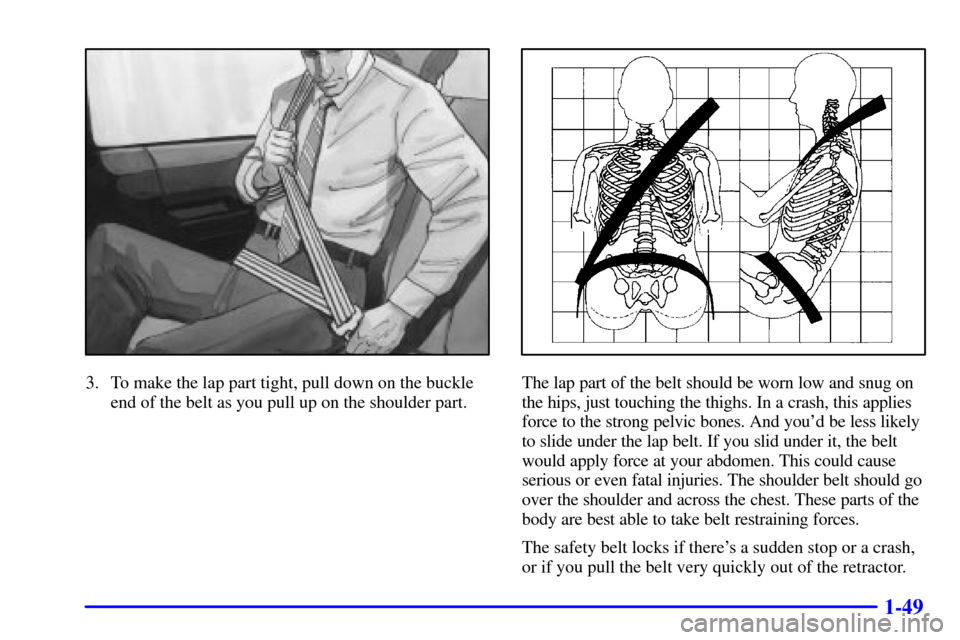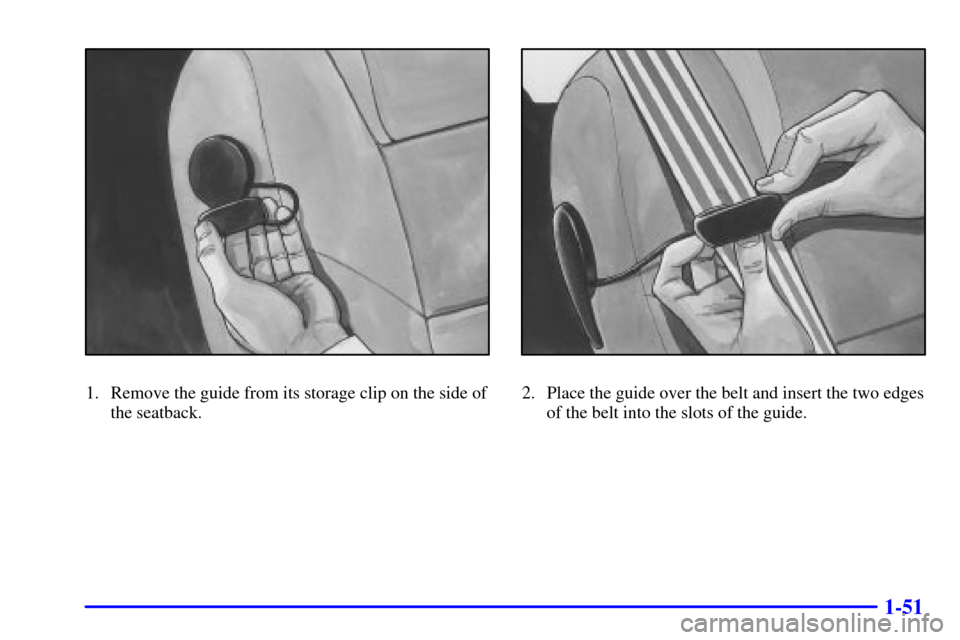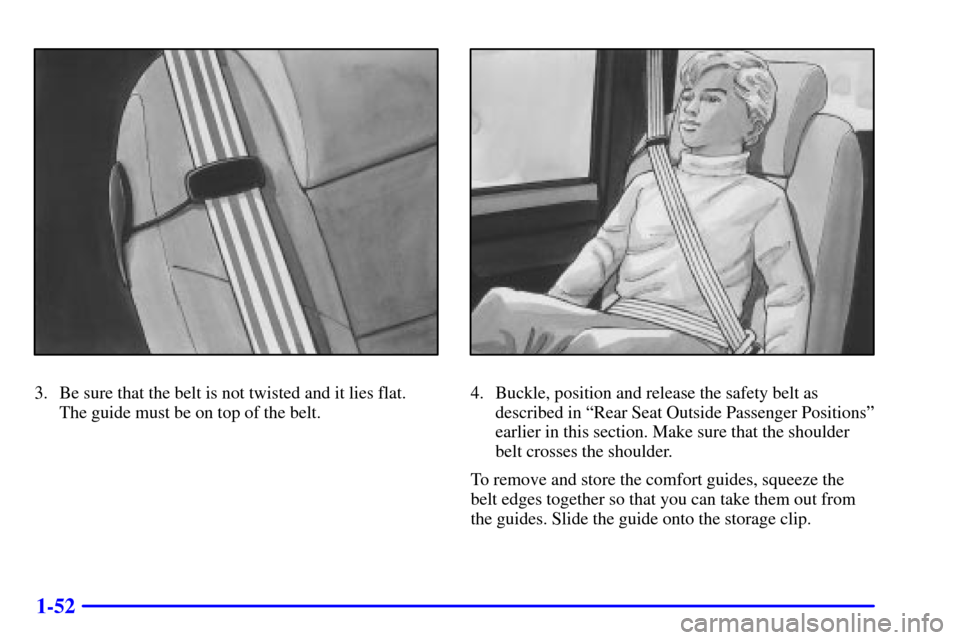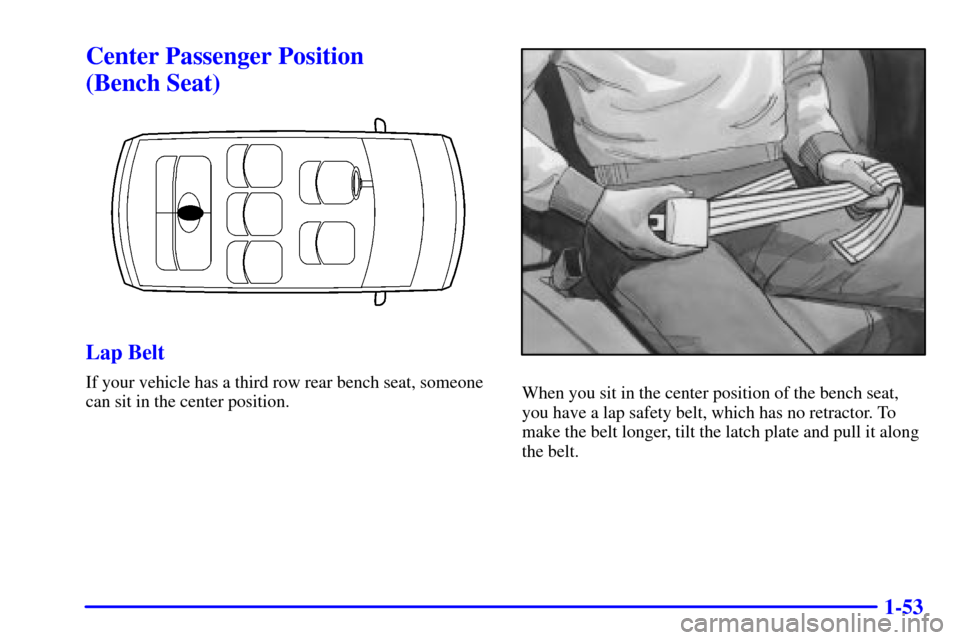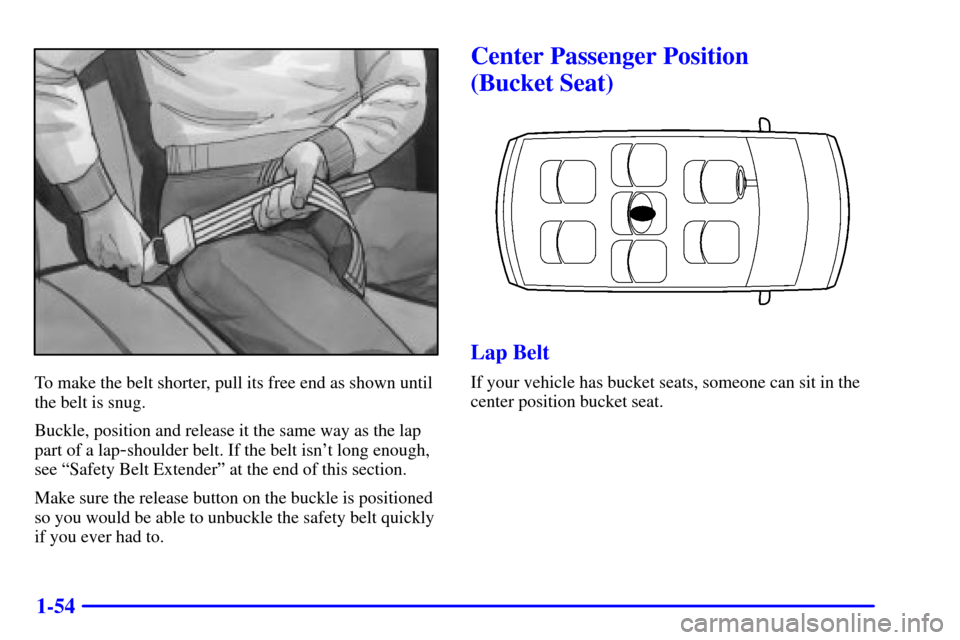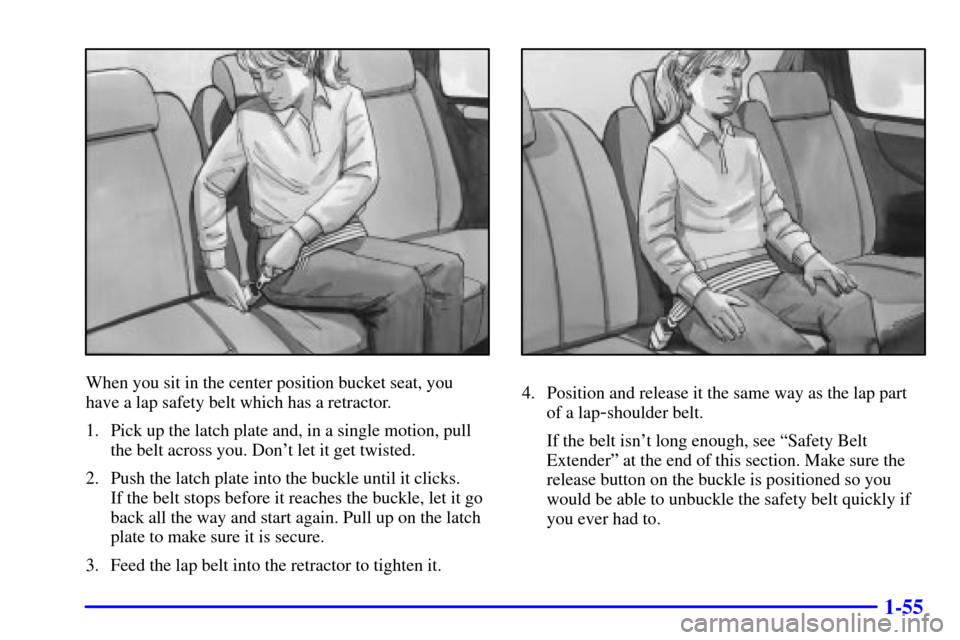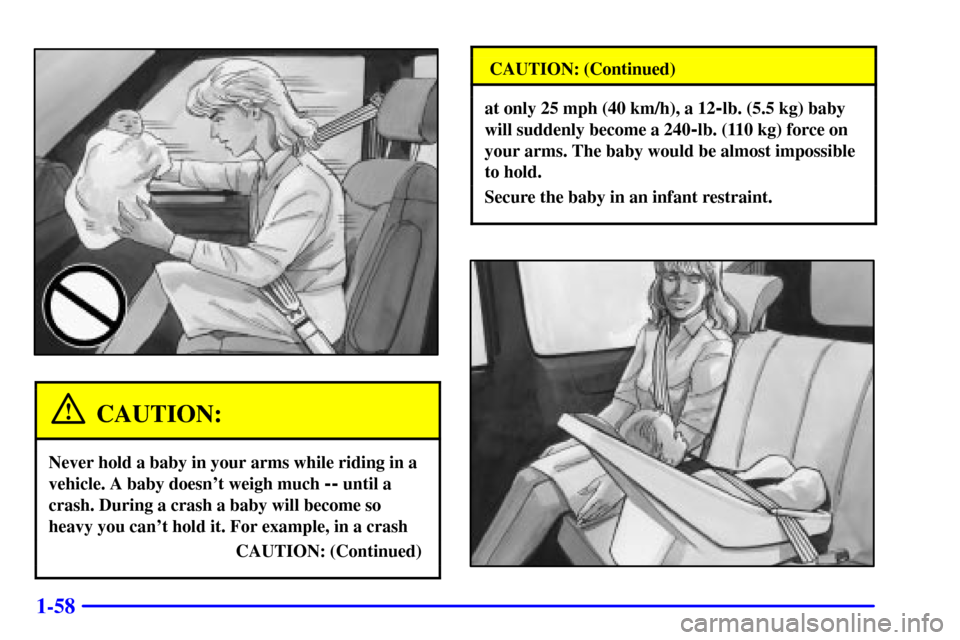CHEVROLET VENTURE 2000 1.G Repair Manual
VENTURE 2000 1.G
CHEVROLET
CHEVROLET
https://www.carmanualsonline.info/img/24/8384/w960_8384-0.png
CHEVROLET VENTURE 2000 1.G Repair Manual
Trending: gas mileage, belt, wipers, maintenance, coolant reservoir, fuel cap, window
Page 61 of 429
1-49
3. To make the lap part tight, pull down on the buckle
end of the belt as you pull up on the shoulder part.The lap part of the belt should be worn low and snug on
the hips, just touching the thighs. In a crash, this applies
force to the strong pelvic bones. And you'd be less likely
to slide under the lap belt. If you slid under it, the belt
would apply force at your abdomen. This could cause
serious or even fatal injuries. The shoulder belt should go
over the shoulder and across the chest. These parts of the
body are best able to take belt restraining forces.
The safety belt locks if there's a sudden stop or a crash,
or if you pull the belt very quickly out of the retractor.
Page 62 of 429
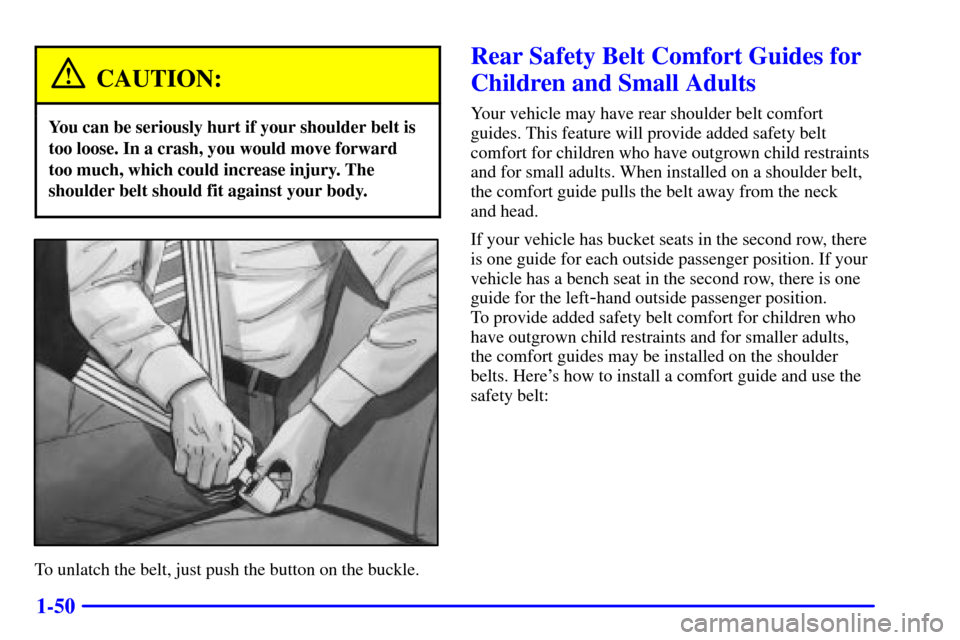
1-50
CAUTION:
You can be seriously hurt if your shoulder belt is
too loose. In a crash, you would move forward
too much, which could increase injury. The
shoulder belt should fit against your body.
To unlatch the belt, just push the button on the buckle.
Rear Safety Belt Comfort Guides for
Children and Small Adults
Your vehicle may have rear shoulder belt comfort
guides. This feature will provide added safety belt
comfort for children who have outgrown child restraints
and for small adults. When installed on a shoulder belt,
the comfort guide pulls the belt away from the neck
and head.
If your vehicle has bucket seats in the second row, there
is one guide for each outside passenger position. If your
vehicle has a bench seat in the second row, there is one
guide for the left
-hand outside passenger position.
To provide added safety belt comfort for children who
have outgrown child restraints and for smaller adults,
the comfort guides may be installed on the shoulder
belts. Here's how to install a comfort guide and use the
safety belt:
Page 63 of 429
1-51
1. Remove the guide from its storage clip on the side of
the seatback.2. Place the guide over the belt and insert the two edges
of the belt into the slots of the guide.
Page 64 of 429
1-52
3. Be sure that the belt is not twisted and it lies flat.
The guide must be on top of the belt.4. Buckle, position and release the safety belt as
described in ªRear Seat Outside Passenger Positionsº
earlier in this section. Make sure that the shoulder
belt crosses the shoulder.
To remove and store the comfort guides, squeeze the
belt edges together so that you can take them out from
the guides. Slide the guide onto the storage clip.
Page 65 of 429
1-53
Center Passenger Position
(Bench Seat)
Lap Belt
If your vehicle has a third row rear bench seat, someone
can sit in the center position.When you sit in the center position of the bench seat,
you have a lap safety belt, which has no retractor. To
make the belt longer, tilt the latch plate and pull it along
the belt.
Page 66 of 429
1-54
To make the belt shorter, pull its free end as shown until
the belt is snug.
Buckle, position and release it the same way as the lap
part of a lap
-shoulder belt. If the belt isn't long enough,
see ªSafety Belt Extenderº at the end of this section.
Make sure the release button on the buckle is positioned
so you would be able to unbuckle the safety belt quickly
if you ever had to.
Center Passenger Position
(Bucket Seat)
Lap Belt
If your vehicle has bucket seats, someone can sit in the
center position bucket seat.
Page 67 of 429
1-55
When you sit in the center position bucket seat, you
have a lap safety belt which has a retractor.
1. Pick up the latch plate and, in a single motion, pull
the belt across you. Don't let it get twisted.
2. Push the latch plate into the buckle until it clicks.
If the belt stops before it reaches the buckle, let it go
back all the way and start again. Pull up on the latch
plate to make sure it is secure.
3. Feed the lap belt into the retractor to tighten it.4. Position and release it the same way as the lap part
of a lap
-shoulder belt.
If the belt isn't long enough, see ªSafety Belt
Extenderº at the end of this section. Make sure the
release button on the buckle is positioned so you
would be able to unbuckle the safety belt quickly if
you ever had to.
Page 68 of 429
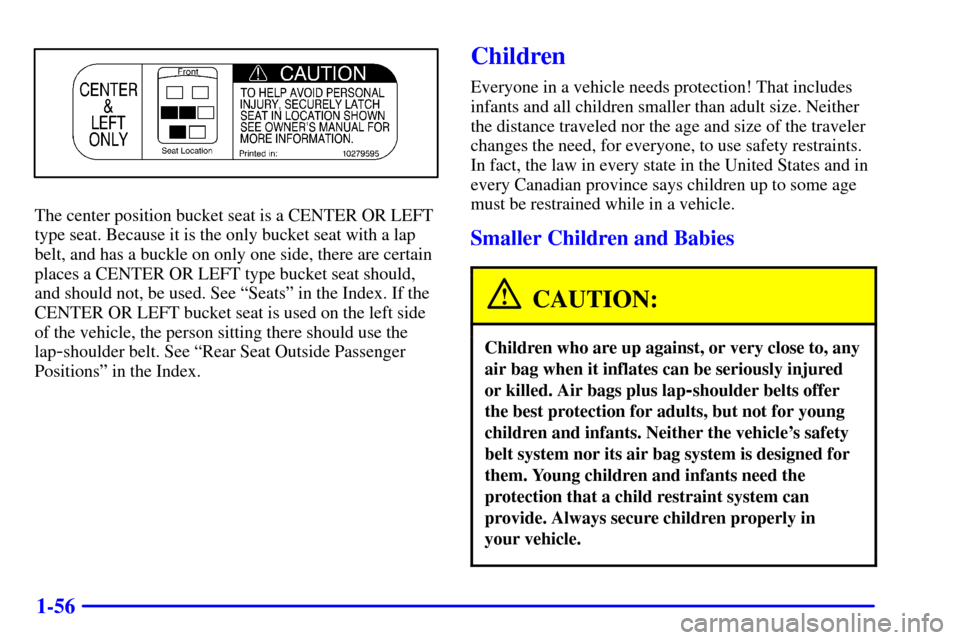
1-56
The center position bucket seat is a CENTER OR LEFT
type seat. Because it is the only bucket seat with a lap
belt, and has a buckle on only one side, there are certain
places a CENTER OR LEFT type bucket seat should,
and should not, be used. See ªSeatsº in the Index. If the
CENTER OR LEFT bucket seat is used on the left side
of the vehicle, the person sitting there should use the
lap
-shoulder belt. See ªRear Seat Outside Passenger
Positionsº in the Index.
Children
Everyone in a vehicle needs protection! That includes
infants and all children smaller than adult size. Neither
the distance traveled nor the age and size of the traveler
changes the need, for everyone, to use safety restraints.
In fact, the law in every state in the United States and in
every Canadian province says children up to some age
must be restrained while in a vehicle.
Smaller Children and Babies
CAUTION:
Children who are up against, or very close to, any
air bag when it inflates can be seriously injured
or killed. Air bags plus lap
-shoulder belts offer
the best protection for adults, but not for young
children and infants. Neither the vehicle's safety
belt system nor its air bag system is designed for
them. Young children and infants need the
protection that a child restraint system can
provide. Always secure children properly in
your vehicle.
Page 69 of 429
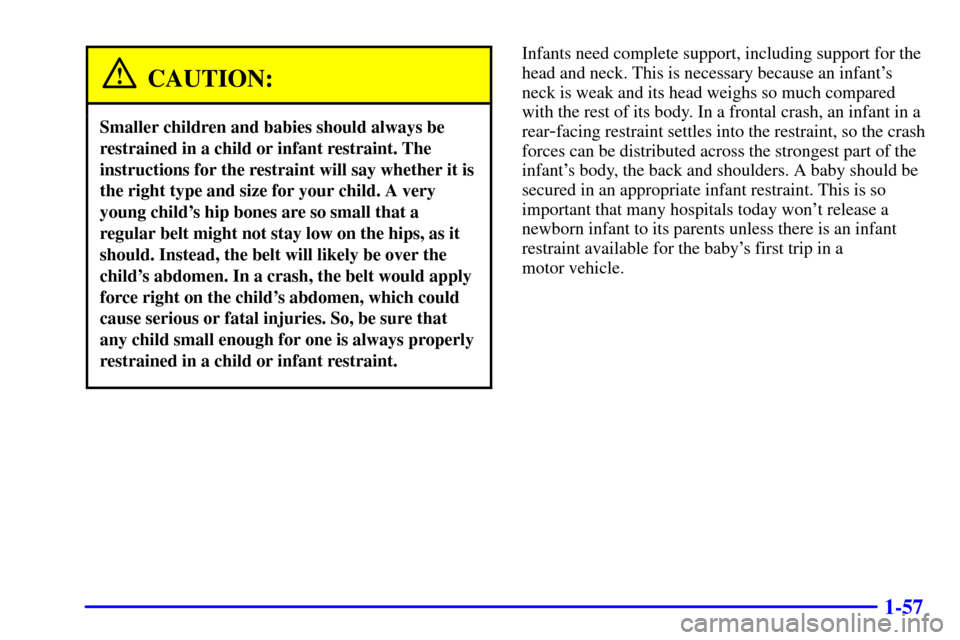
1-57
CAUTION:
Smaller children and babies should always be
restrained in a child or infant restraint. The
instructions for the restraint will say whether it is
the right type and size for your child. A very
young child's hip bones are so small that a
regular belt might not stay low on the hips, as it
should. Instead, the belt will likely be over the
child's abdomen. In a crash, the belt would apply
force right on the child's abdomen, which could
cause serious or fatal injuries. So, be sure that
any child small enough for one is always properly
restrained in a child or infant restraint.
Infants need complete support, including support for the
head and neck. This is necessary because an infant's
neck is weak and its head weighs so much compared
with the rest of its body. In a frontal crash, an infant in a
rear
-facing restraint settles into the restraint, so the crash
forces can be distributed across the strongest part of the
infant's body, the back and shoulders. A baby should be
secured in an appropriate infant restraint. This is so
important that many hospitals today won't release a
newborn infant to its parents unless there is an infant
restraint available for the baby's first trip in a
motor vehicle.
Page 70 of 429
1-58
CAUTION:
Never hold a baby in your arms while riding in a
vehicle. A baby doesn't weigh much
-- until a
crash. During a crash a baby will become so
heavy you can't hold it. For example, in a crash
CAUTION: (Continued)
CAUTION: (Continued)
at only 25 mph (40 km/h), a 12-lb. (5.5 kg) baby
will suddenly become a 240
-lb. (110 kg) force on
your arms. The baby would be almost impossible
to hold.
Secure the baby in an infant restraint.
Trending: CD changer, interior lights, AUX, manual radio set, mirror, low oil pressure, fuse chart
